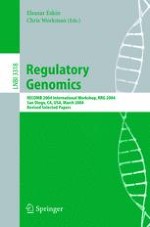
2005 | OriginalPaper | Buchkapitel
Predicting Genetic Regulatory Response Using Classification: Yeast Stress Response
verfasst von : Manuel Middendorf, Anshul Kundaje, Chris Wiggins, Yoav Freund, Christina Leslie
Erschienen in: Regulatory Genomics
Verlag: Springer Berlin Heidelberg
Aktivieren Sie unsere intelligente Suche, um passende Fachinhalte oder Patente zu finden.
Wählen Sie Textabschnitte aus um mit Künstlicher Intelligenz passenden Patente zu finden. powered by
Markieren Sie Textabschnitte, um KI-gestützt weitere passende Inhalte zu finden. powered by
We present a novel classification-based algorithm called GeneClass for learning to predict gene regulatory response. Our approach is motivated by the hypothesis that in simple organisms such as
Saccharomyces cerevisiae
, we can learn a decision rule for predicting whether a gene is up- or down-regulated in a particular experiment based on (1) the presence of binding site subsequences (“motifs”) in the gene’s regulatory region and (2) the expression levels of regulators such as transcription factors in the experiment (“parents”). Thus our learning task integrates two qualitatively different data sources: genome-wide cDNA microarray data across multiple perturbation and mutant experiments along with motif profile data from regulatory sequences. Rather than focusing on the regression task of predicting real-valued gene expression measurements, GeneClass performs the classification task of predicting +1 and -1 labels, corresponding to up- and down-regulation beyond the levels of biological and measurement noise in microarray measurements. GeneClass uses the Adaboost learning algorithm with a margin-based generalization of decision trees called alternating decision trees. In computational experiments based on the Gasch
S. cerevisiae
dataset, we show that the GeneClass method predicts up- and down-regulation on held-out experiments with high accuracy. We explore a range of experimental setups related to environmental stress response, and we retrieve important regulators, binding site motifs, and relationships between regulators and binding sites that are known to be associated to specific stress response pathways. Our method thus provides predictive hypotheses, suggests biological experiments, and provides interpretable insight into the structure of genetic regulatory networks.
Supplementary website:
http://www.cs.columbia.edu/compbio/geneclass